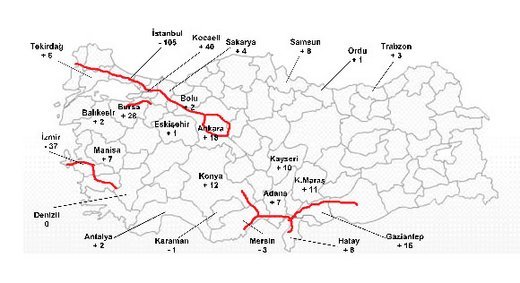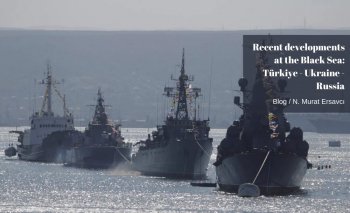TEPAV Articles
- [Archive]
On the Spread of Industry and Expressways in Anatolia... 20/12/2010 - Viewed 2109 times
Since the ban on smoking in closed areas, the event that has excited me most was the groundbreaking ceremony of the Izmir-Izmit expressway. I wish we could see such assertive infrastructure projects more often on the country's agenda. Turkey's shell will change, it will become a high-income country in parallel with the spread of expressway networks throughout the country. The spread of expressways can be understood in a way similar to how the spread of movie theatres in Anatolia has the potential to improve the quality of life and reinforce competitiveness.
Single-lane roads are the arteries of low-income economies; two-lane roads are those of medium-income countries, and three-lane roads of high-income economies. Trucks, buses, taxis and automobiles all mixed up together, speeding up and slowing down, and creating a constant threat is a kind of Third World phenomenon. Similarly, it is an important indicator of economic activity and development when all vehicles travel safely between cities with container trucks in the right lane, commercial vehicles and buses in the middle lane, and high-speed vehicles in the left lane. Turkey's development is related directly to the spread of modern expressways throughout the country. An industrial good produced in one province can reach the market in another province cheaply, seaport connections can be established easily and employees can travel from home to work rapidly only if quality roads are present.
At TEPAV, we have been trying for some time to understand the economic transformation in Anatolia and the connection of the expressways with this transformation. The map below reveals two points regarding this issue. First is the change over the last 13 years in the number of provinces that had more than 5 firms in the largest 1000 industrial enterprise rating of the Istanbul Chamber of Industry between 1997 and 2009. The firms on the list from Istanbul and Izmir decreased by 105 and 37 firms, respectively. On the other hand, 40 from Kocaeli, 28 from Bursa, 18 from Ankara, 15 from Gaziantep, 12 from Konya, and 11 from Kahramanmaraş made it onto the list.
The red lines on the map indicate the location of the expressways. The first point that attracts my attention is that despite the size of the country, there are few expressways. The second point is that there appears to be a direct, positive correlation between the presence of expressways and industrial development. It is most likely that without expressways, the recent industrial development in Kocaeli, Ankara, Gaziantep, Kahramanmaraş and Bursa would not have been witnessed. On the other hand, it is remarkable that Denizli, Eskişehir and Balıkesir, which have the potential to become industrial centers but failed to demonstrate any outstanding progress in the 1997-2009 period, are not on expressway routes. Perhaps Manisa, Kayseri and Samsun, which are connected to other cities via double highways and which have demonstrated an impressive performance in the recent period, could have performed better if they had been located on expressway routes.
It would be best if I not speculate more on this issue since I am not an expert on road planning. In that respect, perhaps listing the questions raised in my mind when considering the map will help stimulate policy debates on this subject:
- Data issued by the Directorate General for Highways reveal that Turkey maintained a strategic preference in favor of double-highways for the 2003-2007 period. The total distance covered by two- and three-lane highways increased from 6100km at the end of 2002 to 19,400km in 2010. This implies an important effort. However, 97 percent of the mentioned increase of 13,331km involved new double-highways; only 3 percent stemmed from new expressways. I wonder whether this negligence in building expressways[1] makes it more difficult for Turkey to become a high-income country, perpetuating the middle-income trap. After all, can we not conclude that expressways contribute much more than double-highways to the economic growth potential of a country?
- The Izmit-Izmir pass, the groundbreaking of which recently occurred, looks as if it will serve as an important solution to the congestion in western Anatolia. But why do medium-term plans not involve a vision that seeks to fill the expressway gap across Central Anatolia, that, for instance, aims to develop the Ankara-Adana and Izmir-Ankara axes and thus to connect the Adana-Gaziantep-Şanlıurfa axes with the west of Turkey? Evidently, expressway investments incur much higher costs that double-highway investments. On the other hand, the fact that the Ankara-Istanbul-Edirne axis was planned and established in Özal's time, as early as in the 1980s, raises questions in my mind, as a that child of the 1980s who learned to drive on the Gebze-Istanbul expressway.
- The Eastern parts of Turkey will develop upon the integration of the region into the Middle East, Central Asia, the Caucasus, the Gulf Countries and Northern Africa as much as into Istanbul. I wonder whether the Turkish Cooperation and Development Agency (TIKA) can accelerate the development in this region by contributing to the planning and financing of expressway construction in addition to restoring Ottoman-era monuments.
Of course, more questions can be raised. The relation of expressway networks to other modes of transportation, such as high-speed trains, can be questioned. The impact of expressways on income distribution and the capital accumulation process, or on traffic accidents, can be debated. However, leaving all other factors aside, when we look at the picture in this way, the lack of a vision for economic development in Anatolia is clear.
Figure 1: Expressways and industrial development
Expressways (red lines, as of 2010) and the change in the number of firms located in the provinces that had more than 5 firms in the largest 1000 industrial enterprise rating of the Istanbul Chamber of Industry by 2009, between 1997 and 2009.

[1] Neither the previous medium-term programs nor that for the 2010-2012 period states any policy objective for increasing the number of expressways. The programs, however, state that the construction of new double-highways will continue.
Esen Çağlar, Economic Policy Analyst, http://www.tepav.org.tr/en/ekibimiz/s/1025/Esen+Caglar














